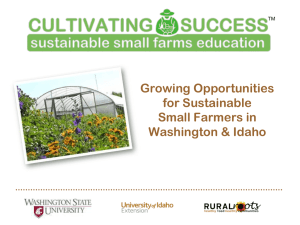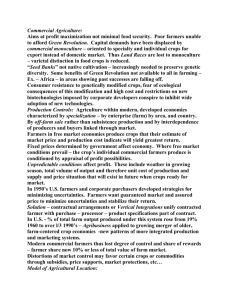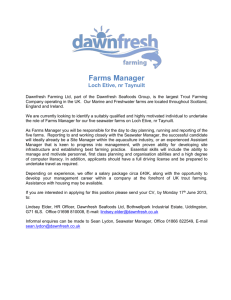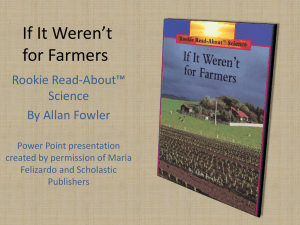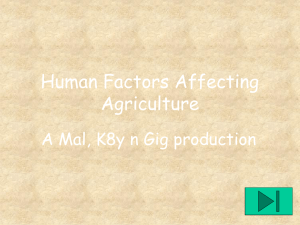Types of Farming In the Standard Grade Geography exam there are
advertisement
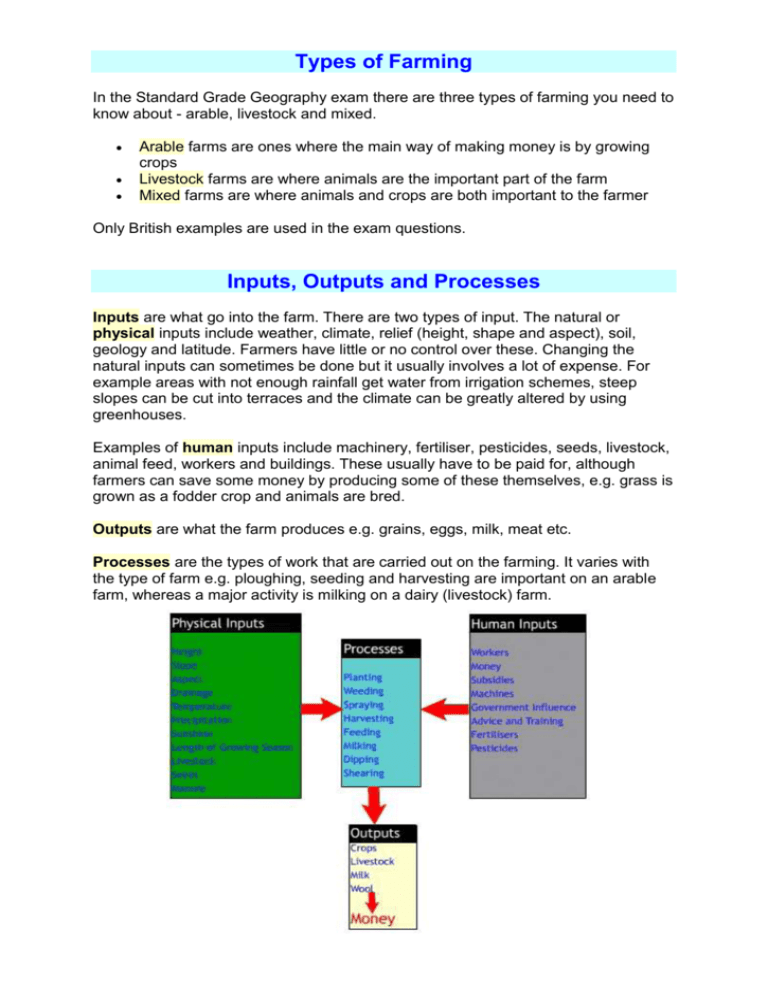
Types of Farming In the Standard Grade Geography exam there are three types of farming you need to know about - arable, livestock and mixed. Arable farms are ones where the main way of making money is by growing crops Livestock farms are where animals are the important part of the farm Mixed farms are where animals and crops are both important to the farmer Only British examples are used in the exam questions. Inputs, Outputs and Processes Inputs are what go into the farm. There are two types of input. The natural or physical inputs include weather, climate, relief (height, shape and aspect), soil, geology and latitude. Farmers have little or no control over these. Changing the natural inputs can sometimes be done but it usually involves a lot of expense. For example areas with not enough rainfall get water from irrigation schemes, steep slopes can be cut into terraces and the climate can be greatly altered by using greenhouses. Examples of human inputs include machinery, fertiliser, pesticides, seeds, livestock, animal feed, workers and buildings. These usually have to be paid for, although farmers can save some money by producing some of these themselves, e.g. grass is grown as a fodder crop and animals are bred. Outputs are what the farm produces e.g. grains, eggs, milk, meat etc. Processes are the types of work that are carried out on the farming. It varies with the type of farm e.g. ploughing, seeding and harvesting are important on an arable farm, whereas a major activity is milking on a dairy (livestock) farm. Farms as Businesses Like shops and factories, a farm is a business. Like all other business it has to make money to survive. Its profits are made when the money the farmer makes by selling his or her outputs is more than is spent on the inputs. Like other business people farmers want to make a substantial profit. Most of the recent changes in farming can be explained by the farmer's desire for a good profit. INPUTS e.g. seeds, climate, relief PROCESSES e.g. milking, harvesting OUTPUTS e.g. eggs, barley PROFIT = VALUE OF OUTPUTS – COST OF INPUTS Arable Farms Arable farms are mainly found in the eastern side of the U.K. Here the land is lower and flatter, the soil more fertile and the climate drier and sunnier. Livestock Farms In Britain the location of livestock farms depends on the main animal that is being kept. Sheep are usually found in the upland areas. They are suited to these parts as Sheep are hardier (tougher) than other animals, and can cope with the colder, wetter and windier conditions They are more surefooted than cattle, so don't mind the steep slopes The land certainly can't be used for arable farming Dairy cattle are more common in the wetter west of Britain as the heavier rainfall helps in the milk production. Lowland areas are favoured as these have warmer temperatures. The south-west of England and Ayrshire in Scotland are particularly suited as the mild winters mean a longer growing season, which in turn means the farmers are less reliant on providing winter feed for the cattle. Dairy farms are also located nearer the larger settlements. This was important in the past when transport was slower and milk needed to get to the market quickly to still be fresh. This location is less important today with refrigerated transport. Mixed Farms Mixed farms have both livestock and crops. They are found where farmers have good quality, fertile land that they can use for arable farming and other land which is more suited for animals. Farmers will often grow fodder crops for their animals, and so save money on livestock feed. Intensive and Extensive Farming Intensive farms have a lot of inputs used on a small area of land. An example would be a market garden that uses a lot of chemicals, buildings, electricity and workers in a very small area of land. Extensive farms have few inputs on a large area of land. An example is a hill sheep farm where perhaps only one farmer will look after a large number of sheep, which do not take a lot of looking after. The Pattern of Land Use on Farms If a farm house is located centrally in area of farmland which is evenly fertile a distinct pattern of landuse may be produced. The farmer will keep the animals and crops that need the most attention in fields that are close to the farmhouse. For example, dairy cattle will be milked twice a day will be close at hand, whereas sheep, which rarely need checking up on, will be more remote. The same is true for crops. Strawberries and raspberries need frequent spraying, fertilising and tending so they will be close by, whilst a grain crop like barley will be planted further away. Changes in British Farms A decline in the number of British farm workers. The reasons for this include Mechanisation - machines take the place of many workers; also fewer horses are used and they needed a lot of looking after Larger farms run efficiently need fewer workers Workers have to be paid - the farm owner wants to make as much money as possible fewer workers = more profit The yield is the amount of a crop that is grown from an area of land. The amount of wheat that British farmers have been able produce from a hectare of land has greatly increased. The reasons for this include Increased use of fertiliser which help the growth of plants Increased use of pesticides which reduce plant disease and damage from insects Greater knowledge and expertise in farming Guarenteed prices from the European Union means the farmers could still get a good price for their crop even if it was overproduced Many hedges have been removed which meant fewer small fields and more efficient farming practices Set-aside is land the farmers are paid not to farm. It was introduced as European Union farmers were producing more crops than people needed. These extra crops then had to be stored, often at great expense. This overproduction has been reduced by farming less land. Set-aside was also introduced to allow nature (plants, insects and animals) to recover away from intensive agriculture, and its reliance on artificial chemicals. Farming Problems The problems that have affected British farms include Overproduction Pollution by Chemicals Growth of Cities Overproduction As mentioned in the Changes in British Farms section, farmers have increased the amount of food they grow on the land. This has led to the creation of wine "lakes" and grain "mountains" - surplus produce that has been stored in warehouses. The problem of too much milk and dairy produce was tackled by the E.U. bringing in quotas. These are limits on the amount of milk each farmer was allowed to produce. The European Union is currently reforming the Common Agricultural Policy (CAP) which many believe was the cause of these problems. It remains to be seen how successful these changes will be. Pollution by Chemicals A lot of modern farming involves the use of chemical fertilisers, insecticides and herbicides. The yields that farmers have been able to produce have grown enormously. However, these chemicals continue to work after they have been washed off the land into rivers and the water supply. This has led to changes in the flora and fauna of intensively farmed areas. River estuaries have suffered from the growth of weed and algae, as the levels of nitrates in the water has increased. Governments have tackled this problem by careful monitoring of pollution levels, with fines for the worst offenders. Some farmers have chosen to go "organic", which means they do not rely on artificial chemicals. As well as having environmental benefits the farmer can charge more for the produce as the consumer is willing to pay extra for organic goods. Growth of Cities Some of the best quality farmland has been lost due to the growth of cities. This urban sprawl is mainly caused by new housing developments, but new industry, out of town shopping centres and multi-lane ring roads and by passes all contribute. One solution is to build within the city in brown-field sites, although these places are not always popular as they have traffic congestion problems and lack of room for expansion. Another is to use a green belt - an area around a city where development is meant to be restricted by law. Such schemes have only had limited success.



